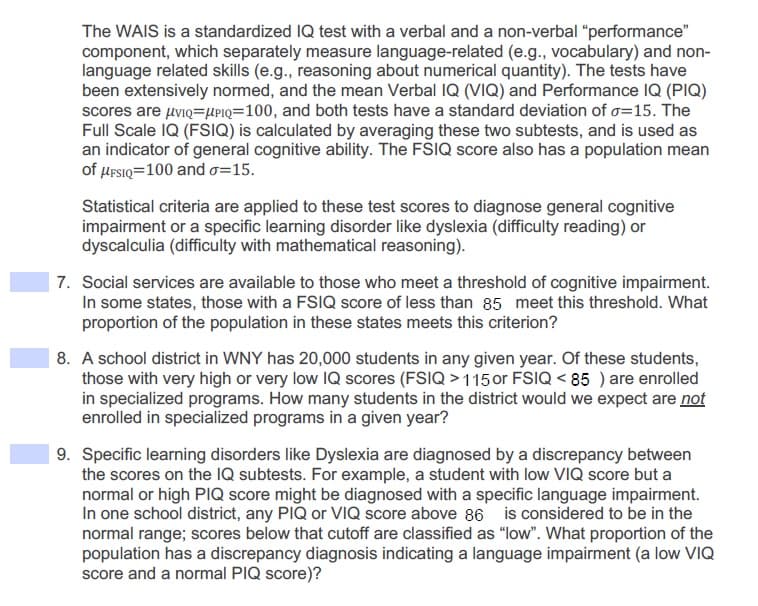The WAIS is a standardized IQ test with a verbal and a non-verbal "performance" component, which separately measure language-related (e.g., vocabulary) and non- language related skills (e.g., reasoning about numerical quantity). The tests have been extensively normed, and the mean Verbal IQ (VIQ) and Performance IQ (PIQ) scores are uviQ=HPIQ=100, and both tests have a standard deviation of o=15. The Full Scale IQ (FSIQ) is calculated by averaging these two subtests, and is used as an indicator of general cognitive ability. The FSIQ score also has a population mean of ursIq=100 and o=15. Statistical criteria are applied to these test scores to diagnose general cognitive impairment or a specific learning disorder like dyslexia (difficulty reading) or dyscalculia (difficulty with mathematical reasoning). 7. Social services are available to those who meet a threshold of cognitive impairment. In some states, those with a FSIQ score of less than 85 meet this threshold. What proportion of the population in these states meets this criterion?
The WAIS is a standardized IQ test with a verbal and a non-verbal "performance" component, which separately measure language-related (e.g., vocabulary) and non- language related skills (e.g., reasoning about numerical quantity). The tests have been extensively normed, and the mean Verbal IQ (VIQ) and Performance IQ (PIQ) scores are uviQ=HPIQ=100, and both tests have a standard deviation of o=15. The Full Scale IQ (FSIQ) is calculated by averaging these two subtests, and is used as an indicator of general cognitive ability. The FSIQ score also has a population mean of ursIq=100 and o=15. Statistical criteria are applied to these test scores to diagnose general cognitive impairment or a specific learning disorder like dyslexia (difficulty reading) or dyscalculia (difficulty with mathematical reasoning). 7. Social services are available to those who meet a threshold of cognitive impairment. In some states, those with a FSIQ score of less than 85 meet this threshold. What proportion of the population in these states meets this criterion?
Glencoe Algebra 1, Student Edition, 9780079039897, 0079039898, 2018
18th Edition
ISBN:9780079039897
Author:Carter
Publisher:Carter
Chapter10: Statistics
Section10.4: Distributions Of Data
Problem 19PFA
Related questions
Concept explainers
Contingency Table
A contingency table can be defined as the visual representation of the relationship between two or more categorical variables that can be evaluated and registered. It is a categorical version of the scatterplot, which is used to investigate the linear relationship between two variables. A contingency table is indeed a type of frequency distribution table that displays two variables at the same time.
Binomial Distribution
Binomial is an algebraic expression of the sum or the difference of two terms. Before knowing about binomial distribution, we must know about the binomial theorem.
Topic Video
Question
100%
answer 7

Transcribed Image Text:The WAIS is a standardized IQ test with a verbal and a non-verbal "performance"
component, which separately measure language-related (e.g., vocabulary) and non-
language related skills (e.g., reasoning about numerical quantity). The tests have
been extensively normed, and the mean Verbal IQ (VIQ) and Performance IQ (PIQ)
scores are uviQ=UPIQ=100, and both tests have a standard deviation of o=15. The
Full Scale IQ (FSIQ) is calculated by averaging these two subtests, and is used as
an indicator of general cognitive ability. The FSIQ score also has a population mean
of HFSIQ=100 and o=15.
Statistical criteria are applied to these test scores to diagnose general cognitive
impairment or a specific learning disorder like dyslexia (difficulty reading) or
dyscalculia (difficulty with mathematical reasoning).
7. Social services are available to those who meet a threshold of cognitive impairment.
In some states, those with a FSIQ score of less than 85 meet this threshold. What
proportion of the population in these states meets this criterion?
8. A school district in WNY has 20,000 students in any given year. Of these students,
those with very high or very low IQ scores (FSIQ > 1150or FSIQ < 85 ) are enrolled
in specialized programs. How many students in the district would we expect are not
enrolled in specialized programs in a given year?
9. Specific learning disorders like Dyslexia are diagnosed by a discrepancy between
the scores on the IQ subtests. For example, a student with low VIQ score but a
normal or high PIQ score might be diagnosed with a specific language impairment.
In one school district, any PIQ or VIQ score above 86 is considered to be in the
normal range; scores below that cutoff are classified as "low". What proportion of the
population has a discrepancy diagnosis indicating a language impairment (a low VIQ
score and a normal PIQ score)?
Expert Solution
This question has been solved!
Explore an expertly crafted, step-by-step solution for a thorough understanding of key concepts.
This is a popular solution!
Trending now
This is a popular solution!
Step by step
Solved in 2 steps with 2 images

Knowledge Booster
Learn more about
Need a deep-dive on the concept behind this application? Look no further. Learn more about this topic, statistics and related others by exploring similar questions and additional content below.Recommended textbooks for you

Glencoe Algebra 1, Student Edition, 9780079039897…
Algebra
ISBN:
9780079039897
Author:
Carter
Publisher:
McGraw Hill

Glencoe Algebra 1, Student Edition, 9780079039897…
Algebra
ISBN:
9780079039897
Author:
Carter
Publisher:
McGraw Hill